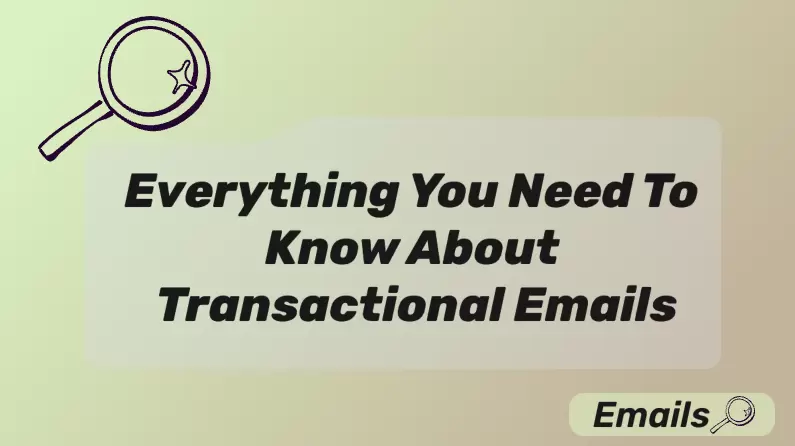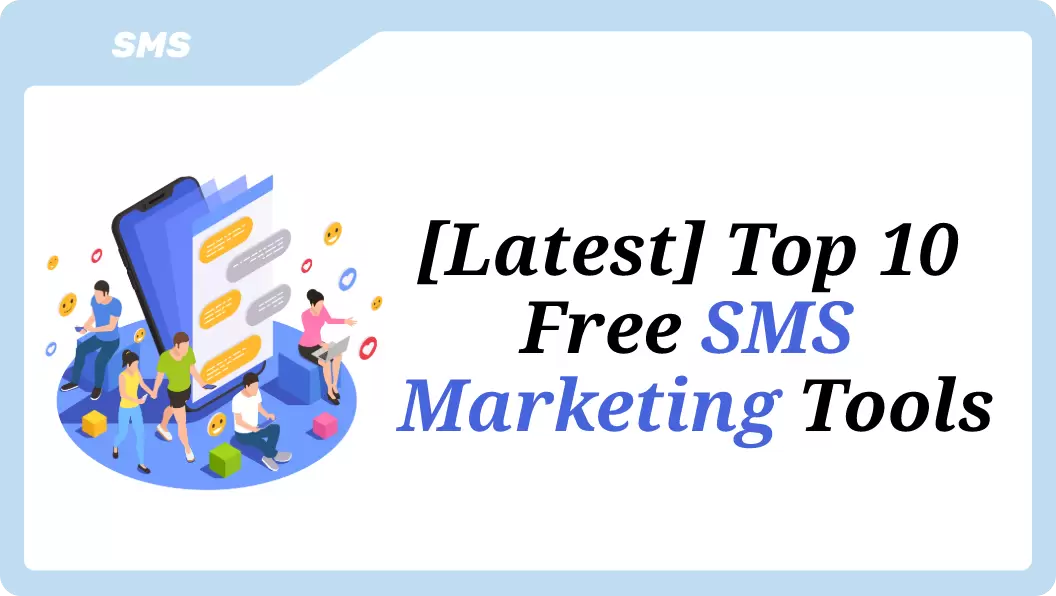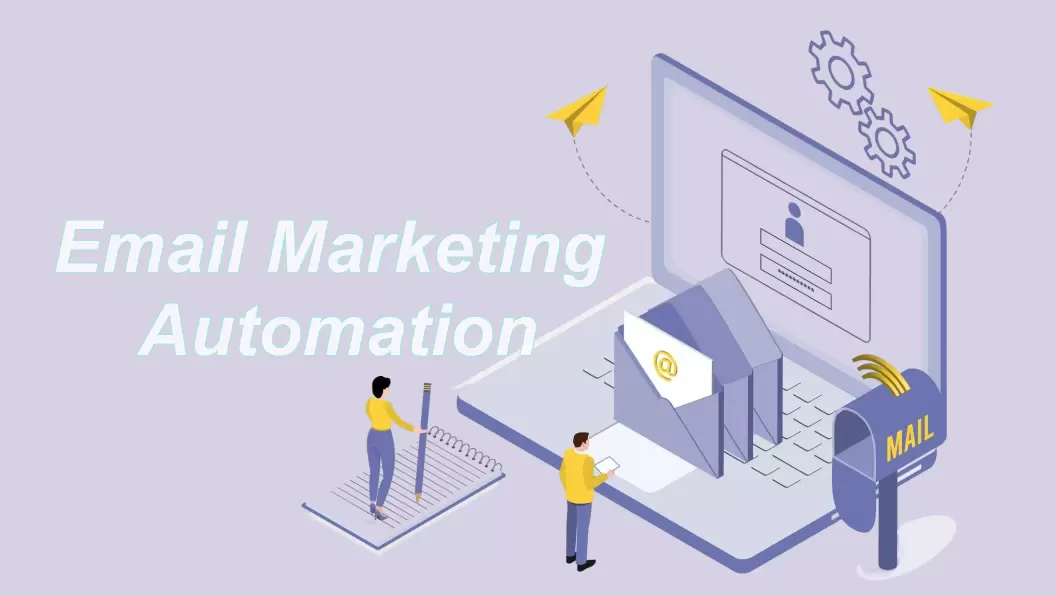Do you want your emails to truly stand out and win over the target customers? Then, you need to learn about creating an effective email marketing customer journey for prospective clients. It is a reliable way of making sure your emails actually convert and do not get lost in the sea of marketing messages.
In this blog post, we'll discuss everything about the process of email customer journey to ensure you are familiar with its benefits, best practices, and creation process to achieve maximum success in email marketing.
Understanding the Email Marketing Customer Journey
The term "customer journey" is a broad term. It refers to the way a customer interacts with your brand and buys your products or services. Generally, a customer journey map is used to visually represent the customers' interactions with brands.
Definition of the Email Marketing Customer Journey
Email marketing customer journey is a more specific type of customer journey that involves analyzing, visualizing, and planning how a recipient will get emails from your brand over a specific time period. It essentially covers different aspects of email recipients' interactions with a brand or organization sending messages via email. I am running a few minutes late; my previous meeting is running over.
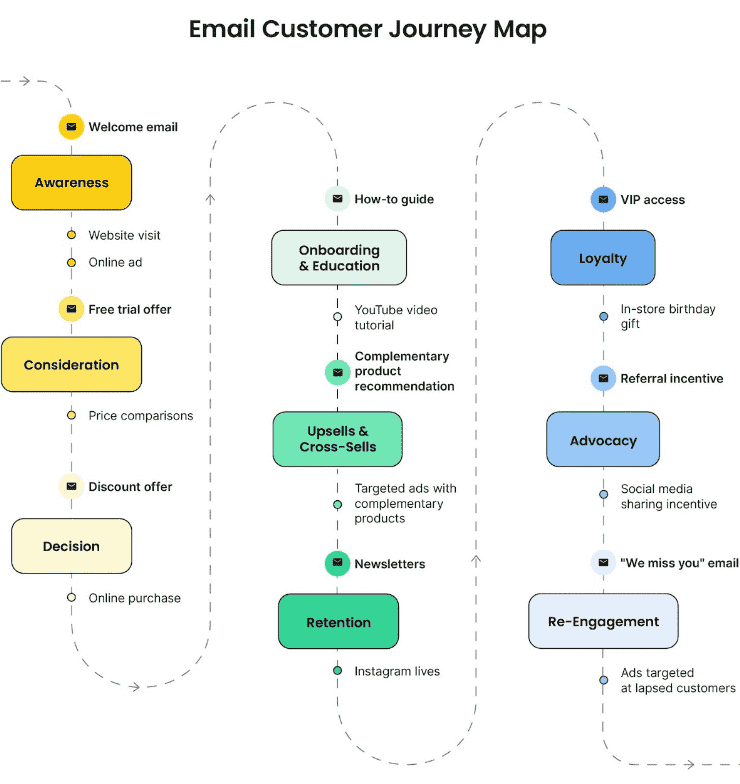
Source:Static-Academy
Being familiar with the nuances of the email customer journey is important for businesses with a customer-centric approach to ensure their email marketing strategies align with the target audience's expectations.
Key Differences and Importance of an Email Customer Journey
Traditional customer journey processes and email marketing customer journey both have the same goal of converting prospects into loyal customers. However, some key differences show the importance of building an email customer journey map:
- Touchpoint: A traditional customer journey has touchpoints across multiple channels, including social media, websites, and physical stores. An email marketing customer journey, however, is all about communicating via email at the right time with the right messaging.
- Permission-Based Engagement: Email marketing is possible when the person on your email list has opted in to receive marketing messages. It creates a relationship dynamic based on trust instead of interruptive marketing that might happen in traditional customer journeys.
- Behavioral Tracking: The kind of detailed behavioral data obtained via email marketing campaigns is simply not possible in traditional touchpoints. Email analytics help you know exactly who opens what and which links caught the attention of prospects.
- Hyper Personalization: The target audience is segmented into broad categories in traditional customer journeys, but an email customer journey map supports personalization at scale based on several factors to ensure success. Personalization, along with automation, can boost revenue by up to 320% as it helps customers complete their journey efficiently.
- Resource Efficiency and Scalability: Traditional customer journey implementation needs significant resources to handle multiple channels. In comparison, an automated email marketing campaign is cost-effective and scalable as it runs on autopilot to ensure consistent communication with customers.
- Improve Customer Experience: Email customer journey eliminates irrelevant messaging and ensures consistent communication with the prospects at every stage. It improves the overall customer experience and helps in building a strong connection.
Overall, brands that recognize that these differences are complementary can fully capitalize on the strengths of the email customer journey to ensure successful integration with the overall marketing ecosystem.
Core Stages of the Email Customer Journey
A successful email marketing customer journey goes through the following five core stages:
Awareness : This is the first contact between a brand and a prospect. You introduce your business's core features and build credibility with potential customers at this stage.
Consideration: Subscribers tend to start evaluating your solution by this stage via value-driven emails that include case studies, comparisons, and tutorials.
Decision/Purchase: The stage where you have to send persuasive and action-focused emails to encourage conversions.
Retention: This stage includes post-purchase emails, such as onboarding sequences and upsell offers, to retain customers and build loyalty.
Advocacy: The emails at the last stage of the customer journey should try to turn satisfied customers into promoters via referral program invitations and review request emails.
Now that you are familiar with the core stages of an email customer journey map, let's see how you can build it.
Step-by-Step Guide: Building Your Email Customer Journey Map
Let's see how exactly you can create an effective email marketing customer journey map in 9 steps:
Step 1: Create Customer Personas and Segment your Audience
First of all, you must have crystal clear information about who you are talking to. Your email customer journey can vary dramatically depending on whether you are targeting first-time visitors or premium clients.
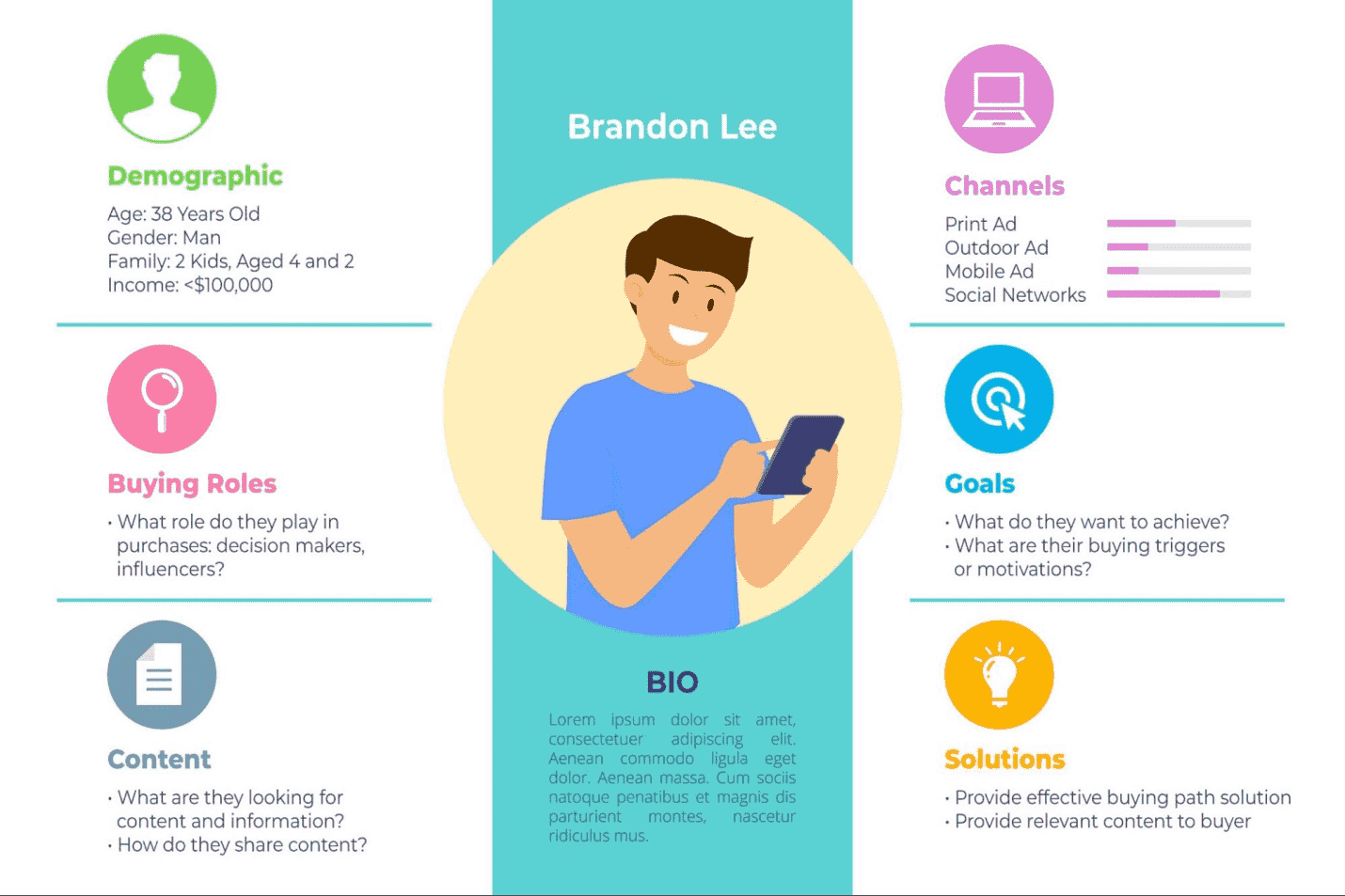
Source:Customerthink
This is why you should start by creating detailed customer personas. These personnel should include:
- Demographics
- Pain points
- Goals
- Communication mode
Now, segment your audience based on key attributes like behavior, buying history, customer engagement level, and lifecycle stage.
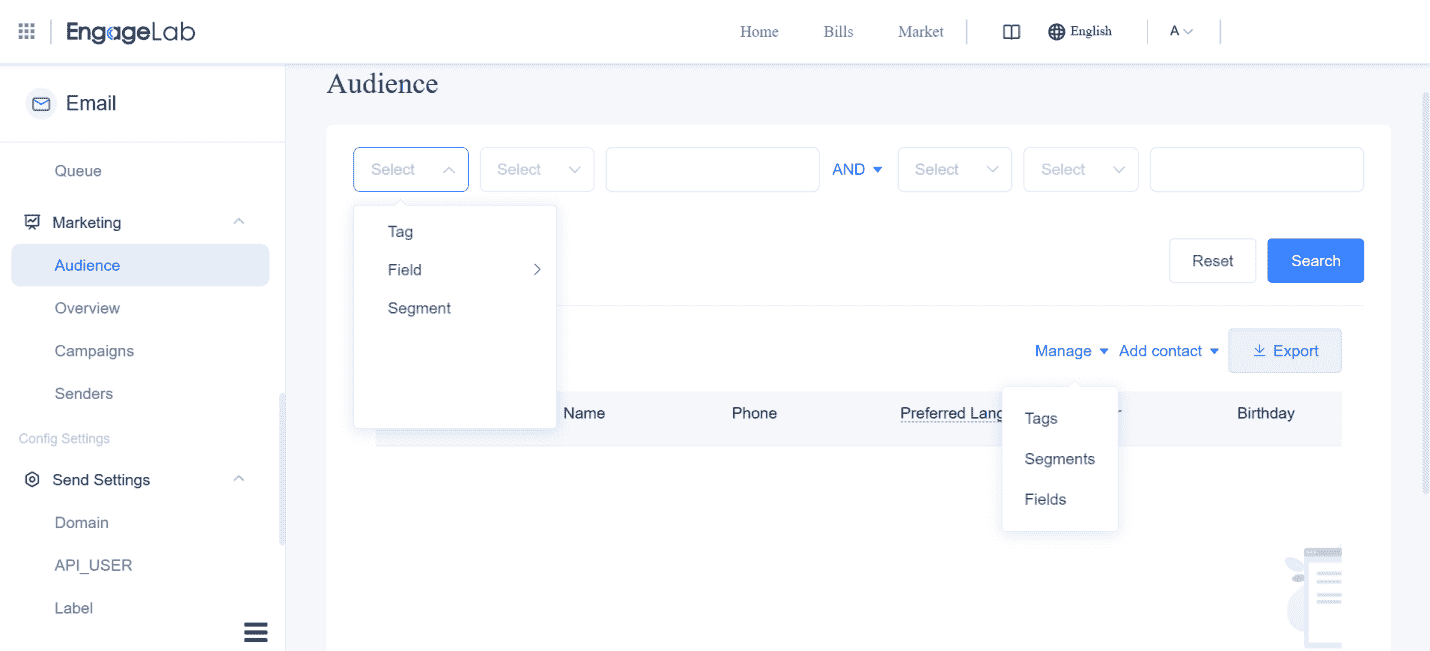
Step 2: Choose the Right Email Automation Platform
Before you start building any customer journey email marketing sequences, you must have a reliable and user-friendly email automation platform to support that. You should look for features like visual automation, segmentation capabilities, personalization, and detailed analytics.
Moreover, an ideal platform integrates with your CRM and other marketing tools to create a unified marketing customer journey experience. We'll discuss more about the top email marketing tools later in this blog.
Step 3: Consider Possible Touchpoints
Your customer journey email map starts by considering all possible touchpoints. You should list every single way someone can interact with your business via email. It is also important to think beyond the simple welcome and promotional emails.
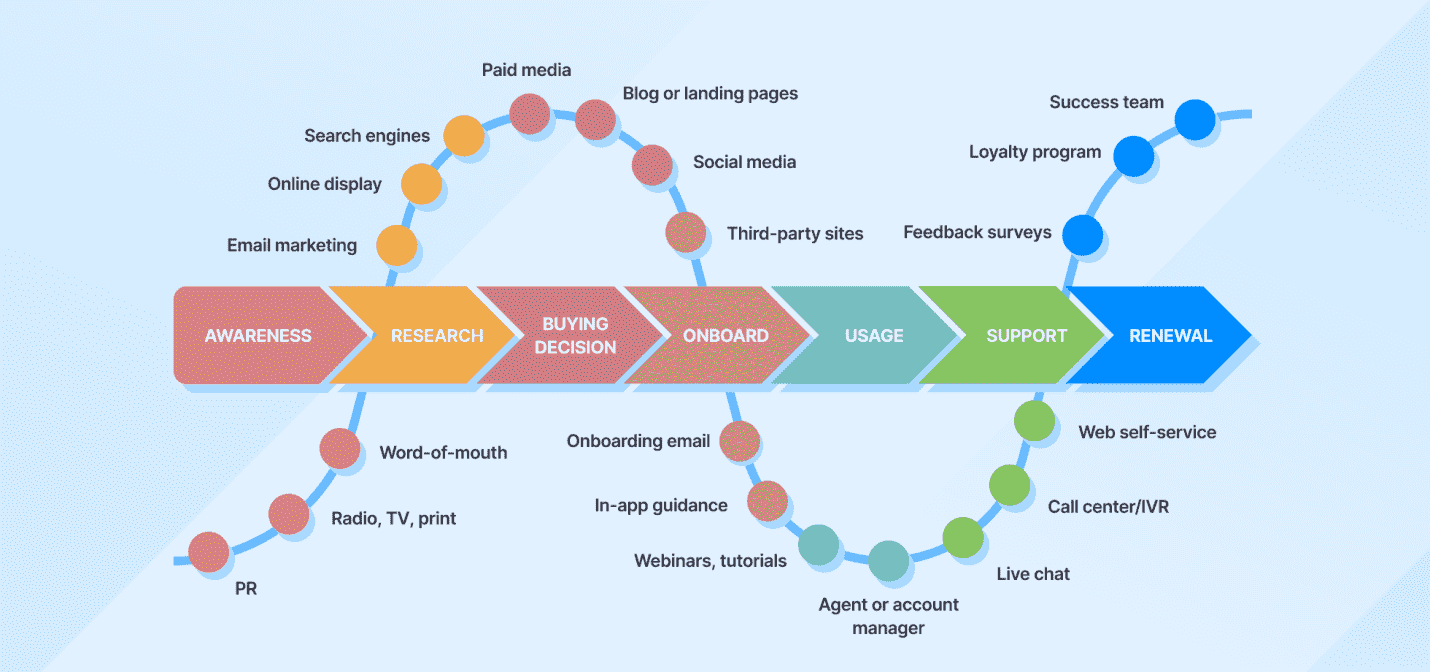
Source: Textmagic
For instance, you should consider scenarios that cater to:
- Abandoned cart sequences
- Post-purchase follow-ups
- Re-engagement campaigns
- Birthday and anniversary messages
- Seasonal marketing campaigns
- Customer feedback requests.
- Triggered emails based on website behavior

Step 4: Identify Goals for Each Customer Journey Stage
Ask yourself, “What do I want to accomplish at each stage of my email marketing customer journey?”
You should be specific. For example,
- Awareness stage: You can try to achieve a 25% open rate and 5% click-through rate.
- Consideration stage: You might want 15% of recipients to download a case study.
- Purchase stage: Goals might focus on achieving a certain conversion rate or average order value.
Overall, having clear metrics for each email customer journey makes the process more efficient and easier.
Step 5: Create Engaging Content for Each Touchpoint
Now you have to get creative and write:
- Engaging content as per email templates
- Persuasive subject lines
- Calls-to-action that drive action for different touchpoints
Be careful in crafting the right messaging with the right tone. Overall, your customer journey email examples need to be relevant to each specific audience group and not like generic marketing messages.
Step 6: Determine Timing and Frequency
Timing can make or break your email customer journey. You need to have clear answers to questions like:
- The gap between your welcome email and the first educational piece
- When should you activate an abandoned cart email campaign?
You should test different intervals to find what works for your specific audience and segments. For example, B2B emails usually perform better on weekdays, while consumer brands see higher engagement on weekends.
Step 7: Set Up Automation and Triggers
By this step, you should have all the knowledge, tools, and data you need to set up an email marketing customer journey map.
Now you can turn it into a reality by configuring your email platform to send the right messages based on specific triggers or time intervals. Ensure your triggers are logical, as you don't want a prospect to receive irrelevant or contradictory messaging.

Step 8: Test, Monitor, and Optimize
You need to track and analyze key metrics at different stages, such as open rate, click-through rate, conversion rate, and revenue per email. Further optimization can be done with the help of A/B testing on subject lines, CTAs, and content formats.
Step 9: Create Feedback Loops Cycles
The best email customer journey maps are the ones that are evolving continuously. So, you should set up regular review periods, monthly or quarterly, to analyze the performance.
Ultimately, building your customer journey email marketing system is an effective way of continuing to enjoy its results for a long period of time. Once the foundation is set right by following the above steps, you can create a powerful ecosystem for sustainable growth.
Customer Journey Email Examples & Solutions
Actual implementation of email customer journey strategies is quite different from understanding the concept. So, let's further explore it in detail with real-world customer journey email examples:
Real-World Customer Journey Email Examples
1. Onboarding Journey
Onboarding email is a critical form of communication to ensure recipients fully know the value proposition and have actionable steps. In the example given below, Mercor has reinforced core benefits and also explained the next steps.

2. Cart Abandonment
Abandoned cart emails need to be a part of your email marketing customer journey. They should create urgency without sounding too salesy to the recipients. An ideal cart abandonment email has a compelling subject line with reference to the items left behind by the recipient.
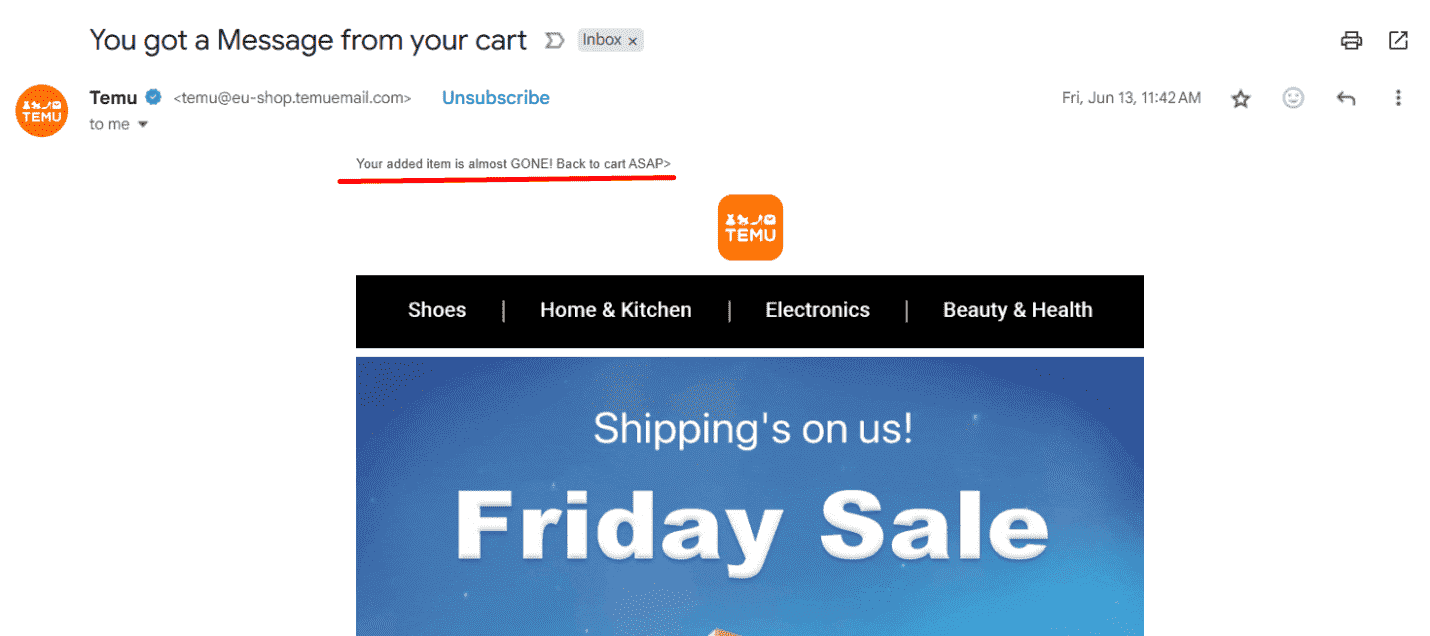
3. Post-Purchase Feedback
Post-purchase emails are often ignored in a customer journey email marketing strategy. The best thank you emails are much more than a simple order confirmation. Instead, they make the purchase decision and also get feedback from the recipients about the brand.

Avoiding Common Email Customer Journey Problems
Here we'll explore some of the most common email customer journey problems and their solutions:
- Generic Messaging: Treating all subscribers identically is a big mistake in customer journey email design. You need to create multiple journey paths and ensure personalization at scale.
- Too Much Information: Never overwhelm new subscribers with each and information about your brand. Instead, send emails with a suitable gap and test different frequencies to find the right balance.
- Ignoring Inactive subscribers: Email customer journey maps are often too focused on engaged subscribers only. But you should also have re-engagement journey sequences to reconnect with inactive subscribers.
- Neglecting Post-Buying Experience: Not getting customer feedback post-purchase can be a huge missed opportunity. Successful email customer journey maps also include post-buying feedback collection and upsell offers.
- Lack of Optimization: Building an email customer journey is not a process that can be completed in just one go. It is a process that requires continuous refinement and optimization.
Measuring and Optimizing Your Email Customer Journey
Before you start optimizing your email customer journey, you need to be familiar with the top metrics to track performance.
Top Metrics to Track Your Email Customer Journey
| Metric | Description |
|---|---|
| Open Rate | Percentage of recipients who open your email |
| Click-Through Rate (CTR) | Percentage of recipients who click on links with your email |
| Conversion Rate | Percentage who completes desired action, such as purchase or download |
| Unsubscribe Rate | Percentage who opts out after receiving an email |
| List Growth Rate | Net rate of new subscribers minus unsubscribes |
| Revenue Per Email | Total revenue generated divided by emails sent |
| Email Sharing Rate | Percentage who forwards or share your email |
| Bounce Rate | Percentage of emails that that could not be delivered |
Optimization Tips
You can optimize your email marketing customer journey map by following these tips:
- Content Optimization: Content and messaging tone are the core of any email marketing campaign. You should A/B test subject lines regularly and ensure personalization.
- Timing and Frequency Optimization: You should experiment with different sending times and frequencies to find the right pattern that suits your target audience's behavior pattern.
- Segmentation Improvements: Create micro-segments and tailor your customer journey email to improve relevance.
- Technical Enhancements: Use a reliable platform with a high deliverability rate to ensure your messages are actually reaching the target audience.
The key thing to remember is that optimization is an ongoing process and not a one-time process. The most successful email marketing customer journey strategies keep evolving based on performance and subscriber feedback.
Comparison of Top Email Customer Journey Mapping Tools
The most important decision in creating an effective email customer journey is perhaps the tool you choose for this process.
The following table summarizes how the leading email customer journey mapping tools function to help create and manage customer journeys.
| Feature | EngageLab MA | Braze | Twilio SendGrid | Mailchimp | HubSpot |
|---|---|---|---|---|---|
| Visual Journey Builder | Advanced drag-and-drop interface | Canvas builder | Basic automation | Customer Journey Builder | Workflow automation |
| Real-time Personalization | AI-powered dynamic content | Liquid templating | Limited personalization | Basic merge tags | Smart content |
| Cross-channel Integration | Email, SMS, push, in-app | Full omnichannel | Email and SMS focus | Primarily email | Multi-channel |
| Advanced Segmentation | Behavioral and predictive | Complex audience builder | Contact database segments | Tags and segments | List segmentation |
| A/B Testing | Multivariate testing | Campaign optimization | Subject line testing | Basic A/B testing | A/B and multivariate |
| Analytics Depth | Comprehensive reporting | Advanced analytics | Detailed metrics | Basic reporting | Attribution reporting |
| API Flexibility | RESTful API and webhooks | Robust API suite | Web API v3 | Marketing API | APIs and integrations |
| Pricing Model | Usage-based, scalable | Enterprise-focused | Usage-based | Subscriber-based | Feature-tiered |
| Best For | Growing businesses | Enterprise brands | Developers | Small and medium businesses | All-in-one marketing |
Industry-Specific Integration Recommendations
Now that you know about the top email marketing customer journey tools, let's see how they fit into different industries:
- E-Commerce Businesses: EngageLab MA and Braze have excellent e-commerce integrations to support online retailers in building successful email marketing campaigns.
- SaaS Companies: SaaS and technological companies often have complex onboarding sequences, so HubSpot and EngageLab MA are the top options here because they have developer-friendly infrastructure.
- Content and Media Companies Mailchimp is a leading option for smaller content businesses, whereas EngageLab MA is also useful for advanced customer journey orchestration and optimization.
Why Choose EngageLab MA for Your Email Customer Journey
EngageLab MA stands out as the top email marketing platform through its features, user-friendliness, and efficiency.

Here's why you should choose EngageLab MA for your email customer journey:
- AI-Powered Personalization: EngageLab MA's algorithms are already learning and adapting to help you optimize and personalize your email marketing campaign at scale.
- Omnichannel Platform: EngageLab is an omnichannel marketing and customer engagement platform helping you reach the target audience via different channels and touchpoints from the same dashboard.
- Visual Journey Builder: You don't have to be an expert to build a complex customer journey, as EngageLab has a drag-and-drop builder to create marketing workflows.
- Cross-Channel Orchestration: Unlike platforms like Mailchimp that focus only on email, EngageLab treats the email customer journey as part of a broader omnichannel marketing effort.
- Enterprise Features with Affordable Pricing: EngageLab allows users to access advanced features like automation, analytics, reporting, and support at a highly affordable price through its usage-based pricing.
So, if you want to build effective email marketing customer journey strategies, you should check out EngageLab MA. You can also contact EngageLab's customer support to get more information and help in designing email customer journeys.
Start Your Free Trial
